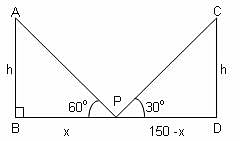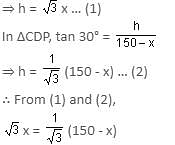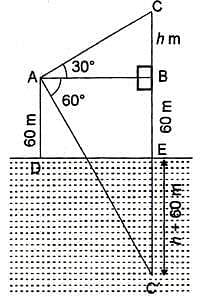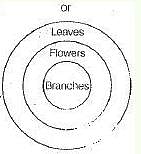CAT Practice Test: Week 21 - CAT MCQ
30 Questions MCQ Test Daily Test for CAT Preparation - CAT Practice Test: Week 21
If cot (x + 27°) = tan y, then which of the following equations is true?
| 1 Crore+ students have signed up on EduRev. Have you? Download the App |
The value of cos 24° + cos 55° + cos 125° + cos 204° + cos 300° is
Find the value of cos2 15° - cos2 30° + cos2 45° - cos2 60° + cos2 75°.
Two pillars of equal height stand on either side of a road, which is 150 m wide. At a point on the road between the pillars, the angles of elevation of their tops are 60° and 30°. Find the height of the pillars.
The angle of elevation of a cloud from a point 60 m above a lake is 30° and the angle of depression of its image in lake is 60°. The height of the cloud is
Solve for the number of solution of the equation: sin(x) + cos(x) = 1 on the interval 0° ≤ x < 360°.
Direction: In the following question, two statements are given followed by three or four conclusions numbered I, II, III and IV. You have to take the given statements to be true even if they seem to be at variance from the commonly known facts and then decide which of the given conclusions logically follows from the given statements disregarding commonly known facts.
Statements: All branches are flowers. All flowers are leaves.
Conclusions:
I. All branches are leaves.
II. All leaves are branches.
III. All flowers are branches.
IV. Some leaves are branches.
Direction: In the following question, two statements are given followed by three or four conclusions numbered I, II, III and IV. You have to take the given statements to be true even if they seem to be at variance from the commonly known facts and then decide which of the given conclusions logically follows from the given statements disregarding commonly known facts.
Statements: All politicians are honest. All honest are fair.
Conclusions:
I. Some honest are politicians.
II. No honest is politician.
III. Some fair are politicians.
IV. All fair are politicians.
Direction: In the following question, two statements are given followed by three or four conclusions numbered I, II, III and IV. You have to take the given statements to be true even if they seem to be at variance from the commonly known facts and then decide which of the given conclusions logically follows from the given statements disregarding commonly known facts.
Statements: Some clothes are marbles. Some marbles are bags.
Conclusions:
I. No cloth is a bag.
II. All marbles are bags.
III. Some bags are clothes.
IV. No marble is a cloth.
Direction: In the following question, two statements are given followed by three or four conclusions numbered I, II, III and IV. You have to take the given statements to be true even if they seem to be at variance from the commonly known facts and then decide which of the given conclusions logically follows from the given statements disregarding commonly known facts.
Statements: Some tables are TVs. Some TVs are radios.
Conclusions:
I. Some tables are radios.
II. Some radios are tables.
III. All radios are TVs.
IV. All TVs are tables.
Direction: In the following question, two statements are given followed by three or four conclusions numbered I, II, III and IV. You have to take the given statements to be true even if they seem to be at variance from the commonly known facts and then decide which of the given conclusions logically follows from the given statements disregarding commonly known facts.
Statements: All terrorists are guilty. All terrorists are criminals.
Conclusions:
I. Either all criminals are guilty or all guilty are criminals.
II. Some guilty persons are criminals.
III. Generally criminals are guilty.
IV. Crime and guilt go together.
Direction: In the following question, two statements are given followed by three or four conclusions numbered I, II, III and IV. You have to take the given statements to be true even if they seem to be at variance from the commonly known facts and then decide which of the given conclusions logically follows from the given statements disregarding commonly known facts.
Statements: Some books are pens. No pen is pencil.
Conclusions:
I. Some pens are books.
II. Some pencils are books.
III. Some books are not pencils.
IV. All pencils are books.
Direction: In the following question, two statements are given followed by three or four conclusions numbered I, II, III and IV. You have to take the given statements to be true even if they seem to be at variance from the commonly known facts and then decide which of the given conclusions logically follows from the given statements disregarding commonly known facts.
Statements: Some houses are offices. Some offices are schools.
Conclusions:
I. Some schools are houses.
II. Some offices are houses.
III. No house is school.
IV. Some schools are offices.
Direction: In the following question, three statements are given followed by four conclusions numbered I, II, III and TV. You have to take the given statements to be true even if they seem to be at variance with commonly known facts and then decide which of the given conclusions logically follows from the given statements disregarding commonly known facts.
Statements: All buildings are windows. No toys is building. Some tigers are toys.
Conclusions:
I. Some tigers are buildings.
II. Some windows are tigers.
III. All toys are tigers.
IV. Some windows are toys.
Direction: In the following question, three statements are given followed by four conclusions numbered I, II, III and TV. You have to take the given statements to be true even if they seem to be at variance with commonly known facts and then decide which of the given conclusions logically follows from the given statements disregarding commonly known facts.
Statements: Some papers are cats. All cats are bats. No bat is horse.
Conclusions:
I. Some papers are horses.
II. No horse is cat.
III. Some bats are papers.
IV. All papers are bats.
In each of the following questions two statements followed by four conclusions numbered I, II, III and IV are given, You have to take the two given statements to take true even if they seem to be at variance from commonly known facts. Read all the conclusions and then decide which of the given conclusions logically follows from the statements.
Statements
All branches are flowers.
All flowers are leaves.
Conclusions
I. All branches are leaves.
II. All leaves are branches.
III. All flowers are branches.
IV. Some leaves are branches.
Directions: The sentence given below may have an error. The sentence has been rewritten under the answer options (1) to (5). Select the option that is the most coherent and precise representation of the sentence.
A balding, smooth faced man, he could have been anywhere between forty and sixty.
Directions: The sentence below has been divided into four parts. Identify the part having an error. If no part has an error, mark (5).
(1) When reminded of his obligation under the rules, (2) he complied with the requirement that all graduate students (3) in education (4) should write a thesis. (5) No error
Directions: The sentence below has been divided into four parts. Identify the part having an error. If no part has an error, mark (5)
(1) Although it might take a laboratory analysis to determine the (2) exact proportions of sand, silt, clay, and organic matter in your garden soil, (3) feel the soil`s texture to get a good idea of (4) what they are. (5) No error
Directions: A part of the sentence is underlined. Five different ways of phrasing the underlined part are given. Choose the best alternative among the five.
Observing the changes in economy sweeping through the world it can be seen that they are spontaneous.
Directions: The sentence below may have an error of grammar or syntax. The following options seek to correct the error (including an option that simply repeats the sentence). Select the option that best corrects the sentence.
New zeal and vigour can be generated by the government among youths by providing employment to youths.
Directions: The underlined part the following sentence may have an error of grammar or syntax. The part has been rewritten in options (2) to (5) in four different ways; (1) being an exact restatement of the underlined part. Choose the option that corrects the error in the underlined part, if any. If there is no error, mark (1).
Seldom have the mathematical theories of games been of practical use in playing real games, although our comprehension of the selection process from among variables may have enhanced.
Directions: The sentence below has an underlined part. The underlined part may have an error of grammar or syntax. There are five options that seek to correct the error (including an option that simply repeats the underlined part). Select the option that best replaces the underlined part.
During his youth, he used to work out ten times as much as he jogged, but today in his middle age he is doing less of it.
Directions: The sentence below has an underlined part. The underlined part may have an error of grammar or syntax. There are five options that seek to correct the error (including an option that simply repeats the underlined part). Select the option that best replaces the underlined part.
After gaining maturity, a child ought to be allowed to make decisions on his own and in pursuing his goals because by that time he is mature sufficiently to decide on his own.
Directions: Look at the underlined part of the given sentence. Below the sentence, are three possible substitutions for the underlined part. Choose the one that is better than the underlined part. In case no improvement is needed, mark (4) as the answer.
Having passed the examination, the college awarded him the best student's medal.
Directions: A part of the sentence is underlined. Five different ways of phrasing the underlined part are given. Choose the best alternative among the five.
Depending on factual evidences, argument is seldom used in pleading.
|
152 docs|327 tests
|


































